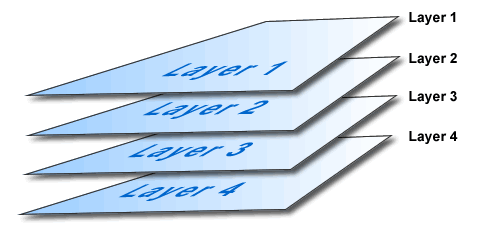The Different Layers of Cyberspace

Cyberspace is often represented by a set of overlapping layers that interact with each other.
The physical layer is the first. It represents the physical infrastructure of the Internet, composed of submarine and terrestrial cables, radio relays, and computers: a set of materials installed on the land, subject to physical and political geography restrictions, that can be designed, changed, or removed, and linked or disconnected from the network.
The logical layer is the second one. It provides all of the resources that ensure data transfer between two points on the network and, as a result, enable information to flow from its sender to its receiver in small data packets. The logical infrastructure is based on an important harmonization, the Internet Protocol (TCP/IP), a shared language that enables all computers on the planet to communicate with one another. It includes routing -the selection of the path through which data packets pass between two networks-, naming -names defining network components or users-, and addressing, which transforms the series of numbers representing the addresses into intelligible words for the users.
The third layer is made up of software, which are computer programs that enable you to access the Internet without having much knowledge of computer programming (ie. Web, e-mail, social networks, search engines, etc.).
Finally, the fourth layer, which is often referred to as cognitive or semantic, is that of knowledge and social exchange. This is the global layer of participants, discussions, and real-time interactions.
The physical layer of cyberspace was created and is now dominated by the United States through the Internet Corporation for Assigned Names and Numbers (ICANN) and the 9 root servers out of 13 located on the American territory. Moreover, via the GAFA (Google, Amazon, Facebook, Apple), the United States also has a dominant position in the software layer, given the penetration rate of their applications. The Western information layer is also dominated by the United States through the economic exploitation of mass data and the added value that comes from it.
So today’s cyberspace is mainly dominated by the United States.
Sources:
- Christophe Gasançon, ‘Le cyberespace, nouvel espace de souveraineté à conquérir’, (May 2018), https://www.geostrategia.fr/le-cyberespace-nouvel-espace-de-souverainete-a-conquerir/
- Frédérick Douzet, ‘La géopolitique pour comprendre le cyberespace’, (2014), https://www.cairn.info/revue-herodote-2014-1-page-3.htm
